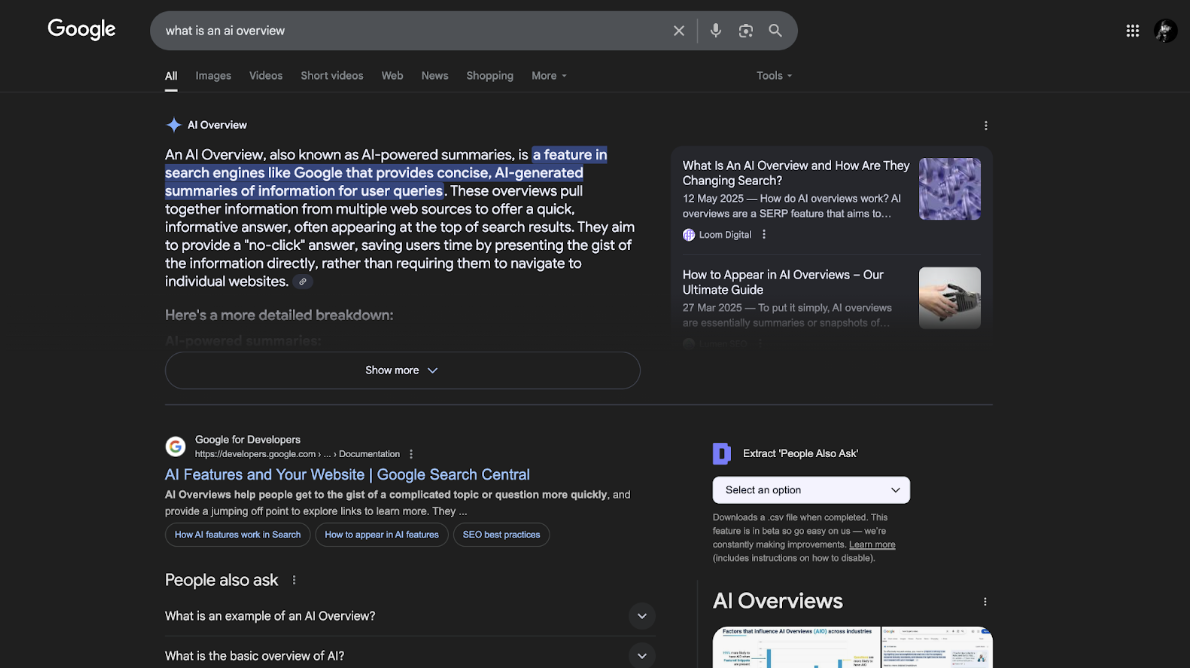
For anyone who has used the internet in the last two decades, the routine is second nature: type a question into Google’s minimalist search bar and receive a list of ten blue links. This digital ritual – a rapid-fire process of scanning titles, judging domains, and opening multiple tabs – is the very foundation of how we navigate the web, a skill honed by billions and the bedrock of the entire search engine optimization industry.
It transformed us all into amateur librarians, sifting through a planetary-scale card catalogue. But that era is rapidly coming to a close as Google rolls out its most significant and disruptive reinvention yet: AI-powered search. This isn’t just a new feature; it’s a fundamental rewiring of our relationship with information, made possible by the recent convergence of near-infinite data, massive computational power, and breakthroughs in artificial intelligence that have finally reached technological maturity.
The Instant Answer Engine
The feature, known as “AI Overviews,” is fundamentally changing the search engine from a digital directory into a direct answer machine. Instead of merely pointing users to other websites, Google’s powerful artificial intelligence, driven by Large Language Models (LLMs), now acts as an instant research assistant. The process involves several steps:
- Reading and Comprehending: The AI first analyzes top-ranked sources for a given query.
- Synthesizing Information: It then synthesizes this information in real-time to form a coherent response.
- Providing a Consolidated Answer: Finally, it provides a single, consolidated, and conversational answer directly at the top of the results page, often eliminating the need to scroll any further.
This process, known in technical circles as Retrieval-Augmented Generation (RAG), is a crucial distinction from earlier AI chatbots. It ensures answers are not just drawn from the AI’s static training data but are grounded in the most current information available on the live web – a critical safeguard against providing outdated information and a key reason this technology is now deemed ready for the primetime of search.
A New Era of Convenience
For users, the change promises an unprecedented level of convenience and a reduction in cognitive load. This transforms the search bar from a simple input box into a collaborative partner in problem-solving. For example:
- Complex Financial Questions: A query like, “What are the key differences between Roth IRAs and traditional IRAs for someone in their 20s, and what are the income limits for contributions?” now yields a summarized list with key features highlighted. This bypasses the traditional, laborious process of opening multiple tabs to cross-reference information from financial blogs, government websites, and investment firms.
- Practical Project Planning: A search for “plan a weekend DIY project to build a raised garden bed” might generate a complete mini-guide, including a materials list, step-by-step instructions, and common pitfalls to avoid, all synthesized from various home improvement sources.
- Conversational Follow-ups: The search experience becomes a dialogue. A user can ask a follow-up question like, “Which of those materials are weather-resistant?” and the AI will refine its answer in context, remembering the previous query.
This direct, multi-faceted response capability significantly streamlines the process of finding information.
The ‘Zero-Click’ Apocalypse for Creators
However, this seismic shift is sending shockwaves through the digital economy, raising critical and urgent questions for the millions of businesses, publishers, and independent content creators who depend on search engine traffic for their livelihood.
This is a direct challenge to the unwritten contract that built the modern web: creators produce quality content, and in exchange, Google sends them traffic, which can be monetized through advertising, affiliate links, or direct sales.
“We’ve spent a decade meticulously optimizing websites to appear on the first page of Google. That visibility is our lifeblood; it’s how customers are found,” said one digital marketing consultant in a recent industry forum. “Our entire business model is built on driving traffic that we can then monetize through ads, affiliate sales, or direct purchases. Now, if Google answers the user’s question directly, the incentive to click through to a source site evaporates. We’re facing a potential ‘zero-click’ apocalypse, and the entire industry is scrambling to figure out what a post-Google-traffic world looks like. It’s an existential threat.”
The new model effectively positions Google as the primary interpreter of the web, not just its indexer. While the AI Overviews provide citations for the information they present, the core concern is that this will drastically reduce traffic to the original content creators. This risks starving the very ecosystem of high-quality, diverse information that the AI itself relies upon.
If the blogs providing expert financial advice, the news outlets doing investigative journalism, and the forums hosting niche communities are no longer financially viable due to a lack of traffic, the well of reliable information could begin to run dry. The result could be a less vibrant, less diverse internet, leaving the AI with a shrinking pool of lower-quality content to synthesize in the future, creating a negative feedback loop where the quality of AI answers degrades over time.
The Pitfalls: Bias and Hallucinations
Experts also point to significant potential pitfalls for the public, demanding a new level of digital literacy. The authoritative tone of an AI-generated answer can mask deep-seated issues. These include:
- Algorithmic Bias: The risk that the AI’s answer may be subtly shaped by unseen commercial partnerships or data-driven assumptions is a major concern. An AI-generated summary of “best running shoes” might favor brands with larger marketing budgets or affiliate relationships with the search provider, rather than the shoes that are objectively best for a user’s needs. More critically, a query for “effective treatments for depression” might generate an answer that overemphasizes pharmaceutical solutions if its source data is dominated by medical journals and pharmaceutical sites, while downplaying therapeutic or lifestyle approaches discussed in psychology blogs. This creates a “tyranny of the average,” where the AI’s consensus-driven answer flattens nuance and marginalizes minority or dissenting viewpoints, which may be crucial for informed decision-making.
- AI “Hallucinations”: The technology is not infallible and is prone to hallucinations, where it can misinterpret data or combine disparate sources to present incorrect information with a disarming veneer of confidence. An AI might, for instance, confidently state incorrect medical advice by misreading a forum post, or attribute a historical quote to the wrong figure, subtly rewriting history in its quest to provide a single, clean answer. It might confidently “confabulate” a legal precedent that doesn’t exist by blending details from two separate court cases, potentially misleading someone doing initial legal research. These falsehoods are particularly dangerous because they are presented within the trusted interface of a search engine, making them more likely to be believed and propagated.
Conclusion: A New Relationship with Information
This move signals a clear and irreversible direction for the future of online information. The search bar is evolving into a conversational assistant, one that will likely become more proactive and deeply integrated into our daily lives.
As Google’s AI gets smarter, the fundamental way we find, trust, and interact with information is being reshaped in real-time. We are witnessing the end of one digital age and the uncertain, complex, and potentially perilous dawn of another. The new era will require us to evolve from being skilled information hunters to being discerning information critics.
The essential skills of the future will include questioning the answers we receive, actively seeking out the cited sources to check for context and interpretation, and understanding the inherent limitations of AI. We must remember the value of the vast, unfiltered, and sometimes messy web that lies just beyond the AI’s neat and tidy summary, as it is the very source of the digital world’s richness and diversity.






